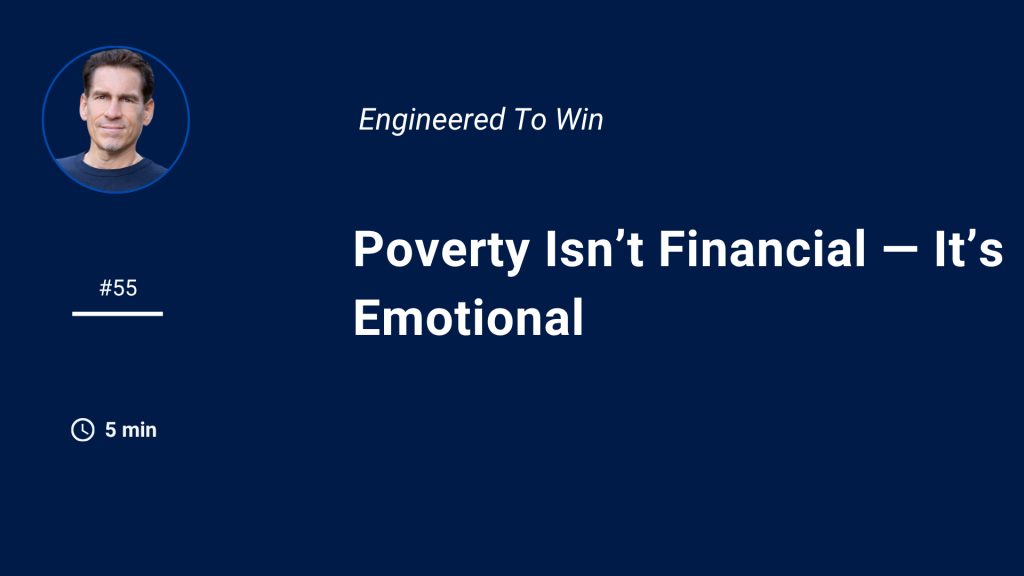Most founders believe their challenges are external: markets, clients, cash flow. The truth is deeper: the real barrier is **emotional poverty** — the felt belief that safety and abundance are always just out of reach.
How Emotional Poverty Hides Behind Performance
Let me tell you about Evan. He runs a multi-million dollar company. To the outside world, he “has it all.” But inside, whenever revenue wavered—even modestly—he’d feel the same visceral tension: tight chest, shallow breath, mental chatter erupting.
In one session, I asked: “When was the first time you remember fearing money?” He didn’t talk about deals or investors. He told me a story from age 8, about his parents arguing over overdue bills. That emotional memory lived in his nervous system long after the money stressors disappeared.
That’s emotional poverty: a body-rooted script that says, “You’re never safe.” No amount of strategy can override it until the subconscious feels real safety.
The Science: Why Scarcity Hijacks Cognition
The brain doesn’t segment “financial pressure” from “danger.” Scarcity — real or perceived — triggers threat circuitry, floods cortisol, and narrows perception. You lose bandwidth, risk tolerance, creativity. Safety shuts things down.
A seminal study in PNAS showed that when chronic debt was unexpectedly relieved, participants improved cognitive function by ~¼ standard deviation, anxiety dropped ~11%, and present-bias decreased ~10%. :contentReference[oaicite:1]{index=1} In other words: debt wasn’t just a line item. It was dragging on their mind.
Another economics study integrates stress into models of poverty, showing that financial stress consumes cognitive capacity and worsens decision-making—turning scarcity into a self-reinforcing trap. :contentReference[oaicite:2]{index=2}
How to Rewire Emotional Poverty
1. Trace the Somatic Origin
Ask:
“When did I first feel unsafe around money or lack?”
Notice the body: chest tightness, gut knots, shallow breathing. That’s your emotional anchor.
2. Regulate Before You Strategize
You can’t out-think threat.
Use a 90-second nervous system reset before tackling any money task:
- Inhale for 4 seconds
- Hold for 4
- Exhale for 8
- Repeat until the body calms
This tells your brain: the threat is over. You can think again.
3. Reframe the Core Script
In your journal each morning, write:
“Money mirrors my internal safety.”
Whenever fear or tension arises, say it until your breath slows. Over time, you’ll rewire your baseline.
⚡ Quick Action Challenge (5 Minutes)
Before you check dashboards, metrics, or revenue numbers — pause.
Scan your body. If there’s tension or anxiety, don’t dive into strategy.
Regulate first, then act.
(Optional: rate stress from 0–10 before & after. Watch the shift.)
Expert Insight: Safety Is the Ground for Growth
Polyvagal Theory (Stephen Porges) teaches that we must feel safe before we expand. Your subconscious uses neuroception — sensing safety or threat — to gate what can emerge.
No strategy, funnel, or hire will break through unless your system trusts it can now receive.
For a deeper dive into how nervous system patterns shape high-performance decision-making, read The #1 Pattern Blocking Your Q4 Results Isn’t in Your Strategy Doc—It’s in Your Nervous System.
Closing Thought + Reflection
You don’t transcend scarcity by earning more.
You transcend it by feeling safe with less.
Because safety is the platform from which abundance grows.
Reflection question:
Where in your life are you still chasing safety instead of creating it?
Recommended Tool
Use Insight Timer (free, no paywall) — search “vagal reset,” “grounding breathwork,” or “body scan.” Pair that practice with your morning journaling.
Call to Action
If this landed, forward it to someone in your network who’s grinding but still feels restless.

